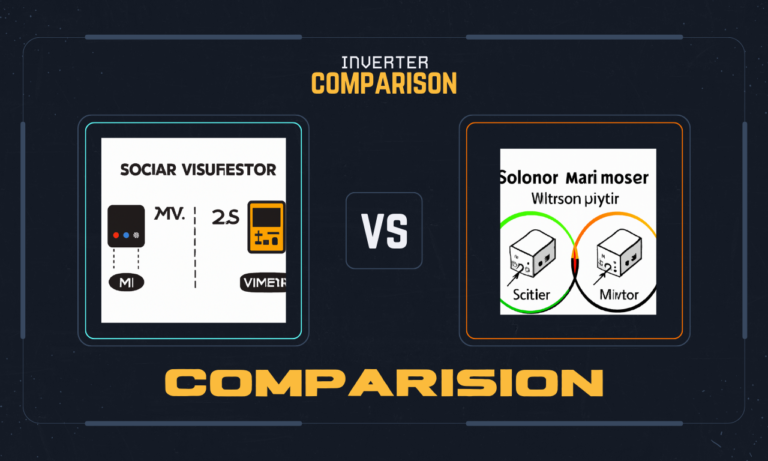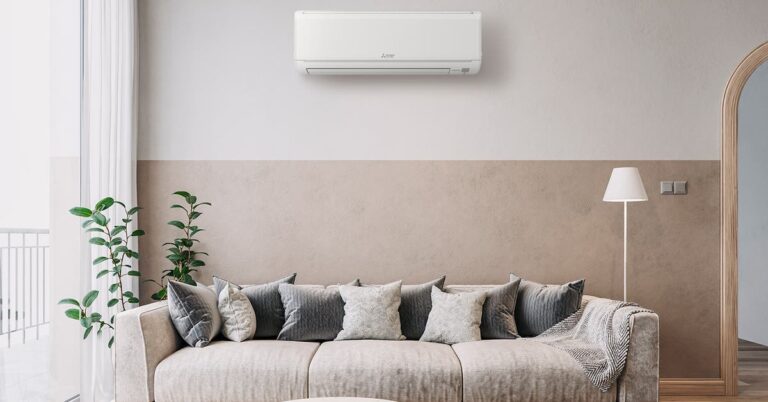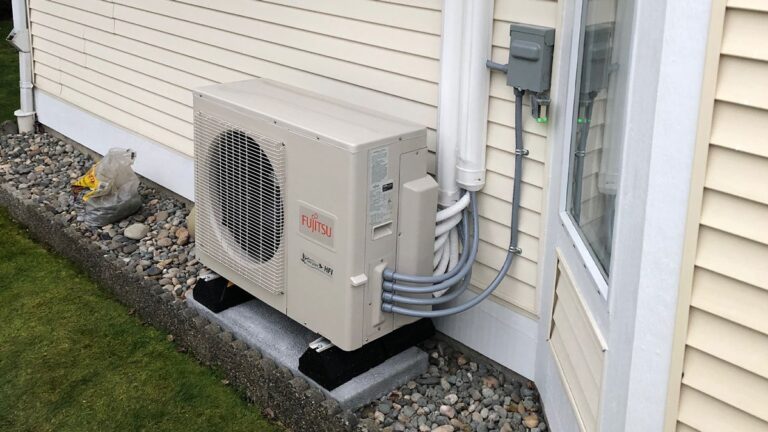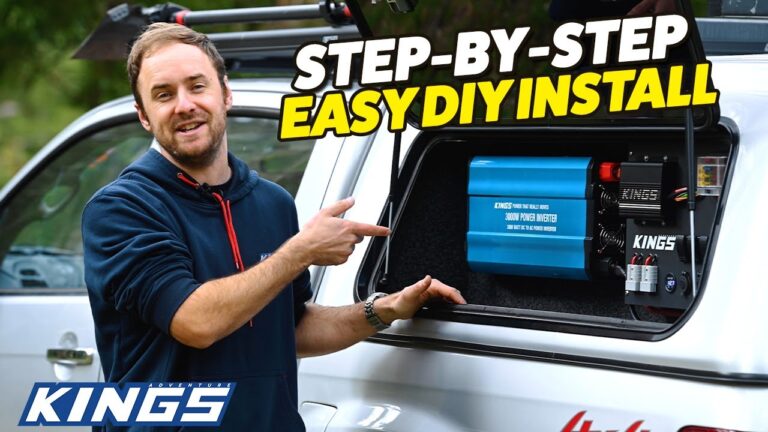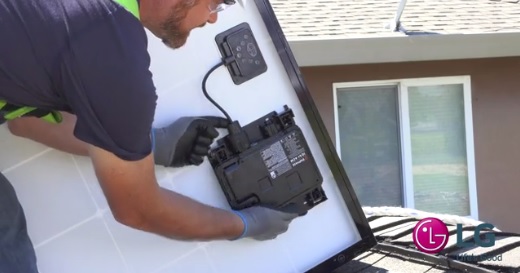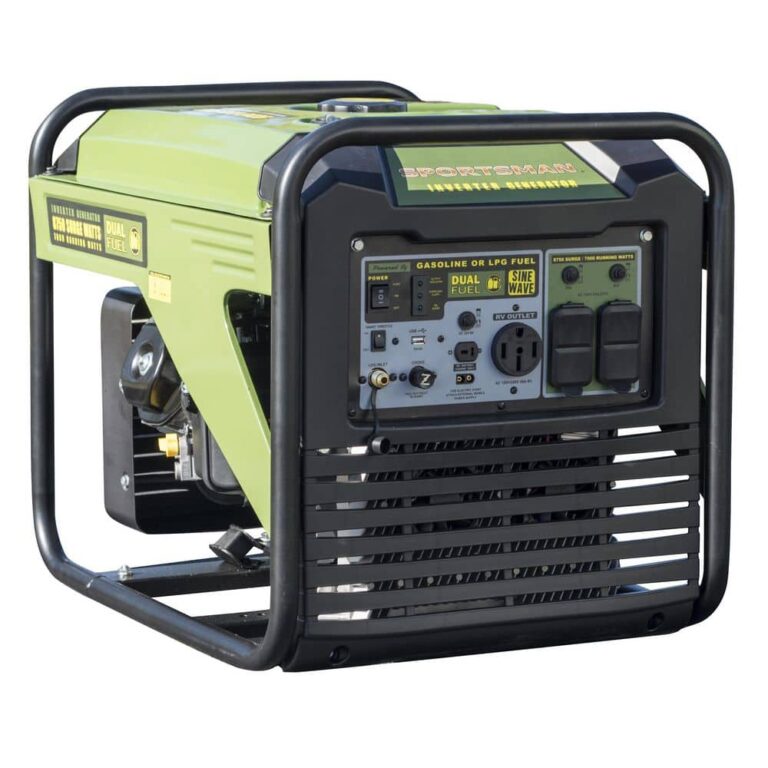Unleashing Independence: The Ultimate Guide to Off-Grid Solar Inverters
Unleashing Independence: The Ultimate Guide to Off-Grid Solar Inverters provides valuable information on the lifespan and sizing of solar inverters for off-grid solar systems. Solar inverters typically last between 10-12 years and play a crucial role in the safe and efficient operation of solar panels.
Extending the lifetime of inverters can have significant benefits to the cost and function of a solar system. When sizing an inverter for an off-grid solar system, it is important to determine the peak load or maximum wattage of your home by adding up the wattage of all appliances and devices that could be run simultaneously.
With this guide, you’ll learn everything you need to know about off-grid solar inverters to achieve energy independence.
What Are Off-Grid Solar Inverters?
Off-grid solar inverters are essential for achieving independence from the grid. This ultimate guide provides valuable insights on how these inverters work and how they can be utilized to power homes and businesses using renewable energy sources like solar power.
To be replaced after that time. However, off-grid solar inverters have a longer lifespan, lasting anywhere from 15 to 20 years or more. This is because they are designed to work independently from the grid and are often built with more durable components to withstand the demands of off-grid living.
Definition Of Off-Grid Solar Inverters:
- Off-grid solar inverters are electronic devices that convert the direct current (DC) power generated by solar panels into alternating current (AC) power that can be used to run household appliances, lighting, and other electrical devices.
- These inverters play a crucial role in off-grid solar systems by storing excess energy in batteries for use during times when the sun is not shining, such as at night or during cloudy weather.
- Off-grid solar inverters are designed to operate independently from the utility grid, providing power in remote locations or areas where access to electricity is limited or unreliable.
Importance Of Off-Grid Solar Inverters In Providing Independence:
- Off-grid solar inverters enable individuals and households to achieve energy independence by generating their own electricity and reducing reliance on traditional utility companies.
- With off-grid solar inverters, people can live in remote areas or build sustainable off-grid homes without the need to connect to the grid, offering a sense of freedom and self-sufficiency.
- Off-grid solar inverters provide a reliable and uninterrupted power supply, even in the event of grid failures or blackouts. This is especially important in areas with frequent power outages or unstable electrical infrastructure.
- Off-grid solar inverters are environmentally friendly, as they harness clean and renewable energy from the sun, reducing reliance on fossil fuels and lowering carbon emissions.
- These inverters also allow for the efficient utilization of solar energy by converting the DC power generated by solar panels into usable AC power that can be stored and used as needed.
- Off-grid solar inverters offer long-term financial benefits by reducing or eliminating monthly electricity bills and providing a return on investment over time. They also help protect against rising electricity costs and provide a hedge against inflation.
Off-grid solar inverters are essential components of off-grid solar systems, providing independence, reliability, and environmental sustainability. They enable individuals and households to generate their own electricity, reduce dependence on the grid, and enjoy the benefits of clean, renewable energy. With off-grid solar inverters, people can embrace a more self-sufficient and sustainable lifestyle while enjoying long-term financial savings.
Types Of Off-Grid Solar Inverters
Unleash your independence with our ultimate guide to off-grid solar inverters. Discover the different types available and learn how they can help you achieve energy self-sufficiency. Say goodbye to reliance on the grid and take control of your power supply.
Off-grid solar inverters play a crucial role in harnessing the power of the sun and converting it into usable electricity. There are different types of off-grid solar inverters available, each with its own unique features and benefits. Let’s explore three popular types:
Pure Sine Wave Inverters:
- Provides a high-quality and smooth AC power output, similar to the grid power supply.
- Compatible with all types of electrical appliances and devices.
- Ideal for sensitive electronics such as laptops, cameras, and medical equipment.
- Offers better performance and efficiency compared to other types of inverters.
Modified Sine Wave Inverters:
- Offers a cost-effective solution for off-grid solar power systems.
- Provides a waveform that is suitable for most appliances and devices.
- Compatible with common household electronics, including basic appliances and power tools.
- May not be suitable for sensitive equipment or devices with specific power requirements.
Grid-Tied Inverters With Battery Backup:
- Designed to work with both the grid power supply and solar panels.
- Provides backup power during grid outages, ensuring uninterrupted electricity supply.
- Excess solar power generated can be stored in batteries for later use.
- Allows users to benefit from net metering, selling excess power back to the grid.
These different types of off-grid solar inverters offer flexibility and options for various off-grid applications. Whether you require a pure sine wave inverter for sensitive electronics, a modified sine wave inverter for basic appliances, or a grid-tied inverter with battery backup for a reliable power supply, there is a suitable option available.
Choose the right type based on your unique energy needs and appliance compatibility.
Factors To Consider When Choosing An Off-Grid Solar Inverter
Choosing the right off-grid solar inverter requires careful consideration of various factors to ensure efficient and reliable operation. From power capacity and efficiency to waveform compatibility and monitoring capabilities, these factors play a crucial role in maximizing the benefits of your off-grid solar system.
Power Output And Capacity Requirements:
- Determine your power needs: Assess your energy requirements to determine the appropriate power output and capacity of the solar inverter.
- Consider peak demand: Choose an inverter that can handle the maximum power demand during peak usage.
- Sizing matters: Ensure that the inverter is properly sized to match the solar panel array and battery bank for optimal performance.
- Overload protection: Look for inverters with built-in overload protection to prevent damage to your system.
Efficiency And Performance:
- High efficiency matters: Opt for inverters with high conversion efficiency to maximize the electricity generated from your solar panels.
- MPPT technology: Consider inverters with Maximum Power Point Tracking (MPPT) technology for improved energy harvesting.
- Temperature tolerance: Check for inverters designed to handle high temperatures, as excessive heat can affect efficiency and performance.
- Manufacturer reputation: Research the manufacturer’s track record for producing reliable, efficient inverters.
Battery Compatibility And Charging Options:
- Battery compatibility: Ensure that the solar inverter is compatible with the type and voltage of your batteries.
- Charging options: Look for inverters with multiple charging options, such as grid charging or generator charging, for flexibility and backup.
- Battery monitoring: Choose inverters with advanced battery monitoring features to keep track of your battery’s health and performance.
- Battery lifespan: Consider inverters that have features to extend the lifespan of your batteries, such as temperature compensation and voltage regulation.
Remember, when choosing an off-grid solar inverter, it’s crucial to consider factors such as power output and capacity requirements, efficiency and performance, as well as battery compatibility and charging options. By assessing your specific needs and selecting a reliable and suitable inverter, you can maximize the benefits of your off-grid solar system.
Sizing Your Off-Grid Solar Inverter System
Discover the ultimate guide to off-grid solar inverters and unleash your independence. Learn all about sizing your off-grid solar inverter system in this comprehensive resource, ensuring efficient and reliable power for your off-grid lifestyle.
Calculating Your Energy Needs:
- Determine your daily energy consumption in kilowatt-hours (kWh)
- Review your past energy bills or use an online energy calculator
- Consider seasonal fluctuations in energy usage
- Identify your desired level of energy independence
- Determine if you want to fully power your off-grid home or have a backup system
- Take into account the efficiency of your appliances and devices
- Use energy-efficient models to reduce overall energy requirements
Determining The Peak Load:
- Determine the appliances and devices you plan to power simultaneously
- List the wattage of each device and their average usage time
- Calculate the total power requirements for all devices
- Add up the wattage of each device to determine the peak load
- Consider surge requirements for certain appliances
- Appliances like refrigerators and air conditioners have higher power requirements upon startup
Choosing The Right Inverter Size:
- Choose an inverter that matches your peak load requirements
- Select an inverter with a power rating equal to or greater than the peak load
- Take into account future expansions or additions to your system
- Plan for increased energy needs in the future and select an inverter that can accommodate them
- Consider the type of inverter suitable for your specific needs
- Pure sine wave inverters provide clean energy for sensitive electronics
- Modified sine wave inverters are more affordable but may not be suitable for certain devices
Remember, accurately sizing your off-grid solar inverter system is crucial for optimal performance and energy independence. By calculating your energy needs, determining the peak load, and choosing the right inverter size, you can ensure that your off-grid solar system meets your power requirements.
Installing Off-Grid Solar Inverters
Installing Off-Grid Solar Inverters is a comprehensive guide that empowers individuals to achieve independence through solar energy. This ultimate guide provides step-by-step instructions and valuable insights on how to install and maintain off-grid solar inverters for a sustainable and self-sufficient lifestyle.
Off-grid solar inverters are an essential component of any off-grid solar power system. These inverters play a crucial role in converting DC (direct current) electricity produced by solar panels into AC (alternating current) electricity that can be used to power your appliances and devices.
Installing off-grid solar inverters can seem like a daunting task, but with the right knowledge and preparation, it can be a straightforward process. In this section, we will guide you through the steps involved in installing off-grid solar inverters, ensuring a successful and safe installation.
Preparing The Solar Panels And Batteries
Before installing your off-grid solar inverter, it is important to ensure that your solar panels and batteries are properly prepared. Here are the key steps to follow:
- Position the solar panels: Determine the optimal location for your solar panels to maximize sun exposure. Ensure that they are securely mounted and angled correctly for your geographic location.
- Connect the solar panels: Link the solar panels together using the appropriate connectors and cables. Check that the connections are tight and secure to prevent any energy loss.
- Prepare the batteries: If you are using batteries to store the energy generated by your solar panels, make sure they are fully charged and in good working condition. Verify the battery capacity is suitable for your energy requirements.
Wiring And Connection Setup
Once your solar panels and batteries are ready, you can proceed with the wiring and connection setup for your off-grid solar inverter. Follow these steps:
- Choose the right inverter: Select an off-grid solar inverter that matches the size and capacity of your solar panel system. Consider factors such as your energy needs, peak power demands, and the inverter’s efficiency.
- Position the inverter: Find a suitable location for your off-grid solar inverter, preferably in a dry and well-ventilated area. Ensure it is easily accessible for maintenance and monitoring.
- Connect the solar panels and batteries to the inverter: Connect the positive and negative terminals of the solar panels and batteries to the respective terminals on the inverter. Follow the manufacturer’s instructions and make sure to tighten the connections properly.
- Verify the connections: Double-check all the connections to ensure they are secure and properly insulated. Faulty connections can result in energy loss or even pose a safety hazard.
- Test the system: Once the connections are in place, test your off-grid solar power system to ensure that the inverter is working correctly. Monitor the output voltage and frequency to ensure they are within the acceptable range.
Safety Considerations
When installing off-grid solar inverters, it is crucial to prioritize safety. Here are some essential safety considerations to keep in mind:
- Disconnect the grid: Always disconnect your solar power system from the grid before installing or working on the off-grid solar inverter. This prevents back-feeding and protects utility workers.
- Use appropriate protective gear: Wear safety gloves and goggles when handling electrical components to protect yourself from potential electrical hazards.
- Follow local electrical codes and regulations: Adhere to the electrical codes and regulations in your area to ensure a safe and compliant installation. Consult a qualified electrician if you are unsure about any aspect of the installation process.
- Regular maintenance: Schedule regular maintenance for your off-grid solar power system, including the inverter. Inspect and clean the system periodically, and promptly address any issues or faults.
Installing off-grid solar inverters requires careful planning and execution. By following the steps outlined in this guide and prioritizing safety, you can successfully unleash the independence of off-grid solar power in your home or property.
Maintaining And Troubleshooting Off-Grid Solar Inverters
Discover the ultimate guide to maintaining and troubleshooting off-grid solar inverters in “Unleashing Independence: The Ultimate Guide to Off-Grid Solar Inverters. ” This comprehensive resource provides valuable insights and practical tips for maximizing the efficiency and longevity of your solar power system.
Off-grid solar inverters are an essential component of any off-grid solar power system. They play a crucial role in converting the DC power generated by solar panels into usable AC power for your appliances. To ensure your off-grid solar inverter continues to perform efficiently and to troubleshoot any issues that may arise, regular maintenance tasks, monitoring, and diagnosing issues, as well as troubleshooting common problems, are necessary.
Let’s dive into these areas in more detail:
Regular Maintenance Tasks:
Maintaining your off-grid solar inverter is vital for its long-term performance and reliability. Here are some regular maintenance tasks you should consider:
- Clean solar panels periodically to remove dirt, debris, and dust that can affect their efficiency.
- Inspect cables and connections for any signs of wear, damage, or loose connections.
- Check the inverter’s fan and vents, ensuring they are clear of any obstructions.
- Monitor and maintain appropriate battery levels to prevent overcharging or discharging.
- Regularly update the inverter’s firmware to benefit from improved performance and bug fixes.
Monitoring And Diagnosing Issues:
Monitoring your off-grid solar inverter allows you to stay informed about its performance and detect any potential issues early on. Here are some essential monitoring and diagnostic tasks:
- Use monitoring software or devices to track the inverter’s energy production, voltage, and power output.
- Monitor battery levels and charge/discharge cycles to optimize their lifespan and performance.
- Keep an eye on warning or error messages displayed by the inverter’s interface or monitoring system.
- Analyze performance data to identify any underperforming panels or potential areas of improvement.
- Regularly inspect the inverter for physical damage, loose connections, or signs of overheating.
Troubleshooting Common Problems:
When issues arise with your off-grid solar inverter, troubleshooting is essential to get your system back up and running. Here are some common problems and troubleshooting steps to consider:
- No power output: Check if the inverter is receiving sufficient sunlight and if the cables and connections are secure.
- Overheating: Ensure the inverter is adequately ventilated and free from any obstructions. Consider installing additional cooling measures if needed.
- Error codes: Refer to the inverter’s manual or contact the manufacturer to understand and address specific error codes.
- Battery issues: Check battery connections, voltage levels, and charge status. Replace batteries if necessary.
- DC/AC mismatch: Verify the solar panels’ specifications match the inverter’s input requirements.
Remember, proper maintenance, regular monitoring, and timely troubleshooting are key to maximizing the efficiency and longevity of your off-grid solar inverter. Stay vigilant and address any issues promptly to enjoy uninterrupted power from your off-grid solar system.
Maximizing The Efficiency Of Off-Grid Solar Inverters
Maximize the efficiency of off-grid solar inverters with the ultimate guide to achieving independence from the grid. Learn how to optimize performance and extend the lifespan of your solar system for cost-effective and reliable power generation.
Provide reliable and efficient conversion of DC power from solar panels to AC power for off-grid systems. In order to maximize the efficiency of off-grid solar inverters, there are several key strategies to consider:
Optimizing Energy Consumption:
- Implementing energy-efficient appliances and equipment can significantly reduce the overall energy consumption of an off-grid system.
- Using power management systems, such as timers and smart plugs, to control and minimize the usage of electricity during peak demand hours.
- Regularly monitoring and analyzing energy consumption patterns to identify areas of improvement and adjust usage accordingly.
Using Energy Storage And Backup Systems:
- Incorporating energy storage solutions, such as batteries, allows for the storage of excess energy generated during peak sunlight hours for use during periods of low sunlight or high demand.
- Employing backup systems, such as diesel generators or wind turbines, provides a reliable source of power in case of extended periods of low sunlight.
Integrating Smart Technologies:
- Utilizing advanced monitoring and control systems, such as smart inverters, allows for real-time monitoring of system performance and optimization of power generation.
- Integrating smart home technologies, such as energy management systems and smart thermostats, enables seamless control and automation of energy usage for maximum efficiency.
By implementing these strategies, off-grid solar inverters can operate at their highest potential, maximizing energy conversion and utilization while minimizing waste. This ensures a sustainable and independent power supply for off-grid living. Remember, the key to success lies in understanding and optimizing energy consumption, utilizing energy storage and backup systems, and integrating smart technologies for efficient off-grid solar systems.
Pros And Cons Of Off-Grid Solar Inverters
Discover the pros and cons of off-grid solar inverters, essential for independent solar power systems. These inverters can provide freedom from the grid, allowing you to generate and store your own electricity. However, they may require a higher upfront cost and maintenance compared to grid-tied systems.
Unleashing Independence: The Ultimate Guide To Off-Grid Solar Inverters
Off-grid solar inverters play a crucial role in enabling independent living by converting direct current (DC) power from solar panels into alternating current (AC) power that can be used to run household appliances and electronics. These inverters serve as the backbone of off-grid solar systems, providing reliable and sustainable electricity.
However, like any technology, they come with their own set of advantages and limitations. In this section, we will explore the pros and cons of off-grid solar inverters. Let’s dive in!
Advantages Of Off-Grid Solar Inverters:
- Energy Independence: Off-grid solar inverters empower users to free themselves from the limitations and costs associated with traditional utility grids. They provide a reliable source of electricity even in remote areas where access to the grid may be challenging or nonexistent.
- Environmental Sustainability: By harnessing the power of the sun, off-grid solar inverters contribute to a cleaner and greener planet. They reduce reliance on fossil fuels and minimize carbon emissions, helping to combat climate change and preserve the environment for future generations.
- Cost Savings: Off-grid solar inverters offer significant financial benefits over time. Once installed, they generate electricity for free, eliminating or greatly reducing monthly utility bills. Additionally, government incentives and tax credits are often available to further offset initial installation costs.
- Versatility and Flexibility: Off-grid solar inverters can be customized to meet individual energy needs. Whether you want to power a small cabin or a large off-grid home, these inverters can scale accordingly, providing the flexibility to expand or upgrade the system as required.
Limitations And Challenges:
- Initial Investment: While off-grid solar inverters can lead to long-term cost savings, the initial upfront investment can be a significant barrier for some. The cost of solar panels, batteries, and inverters, as well as installation fees, must be considered when determining the feasibility of going off-grid.
- Limited Power Output: Off-grid solar inverters are designed to meet the average daily energy requirements of a household. However, during periods of low sunlight or increased energy consumption, such as during extreme weather conditions, the system’s power output may be limited. This limitation necessitates careful energy management to avoid excessive power usage during these times.
- Battery Maintenance: Off-grid solar systems rely on batteries to store excess energy for use when the sun is not shining. Proper battery maintenance, including regular inspections, cleaning, and replacement as needed, is essential to ensure the longevity and performance of the system.
- Technical Knowledge and Support: Off-grid solar inverters require a certain level of technical knowledge for installation, maintenance, and troubleshooting. Access to reliable technical support and resources may be limited in remote locations, making it necessary for users to educate themselves and have the skills to address any issues that may arise.
Understanding the advantages and limitations of off-grid solar inverters is crucial when considering the switch to a self-sustaining energy system. While these inverters offer numerous benefits such as energy independence, sustainability, cost savings, and flexibility, they also come with challenges like the initial investment, power output limitations, battery maintenance, and the need for technical knowledge and support.
By weighing these factors and considering individual circumstances, one can make an informed decision about harnessing the power of off-grid solar inverters.
Future Trends In Off-Grid Solar Inverters
Discover the future trends in off-grid solar inverters with the ultimate guide to achieving independence. Learn how to harness solar power and explore the advantages of off-grid systems for your energy needs.
As the demand for off-grid solar power systems continues to rise, manufacturers and developers are constantly innovating to enhance the efficiency and performance of solar inverters. In this section, we will explore some of the key future trends in off-grid solar inverters, including innovations in efficiency and performance, integration with energy storage and grid systems, and their impact on sustainable living.
Innovations In Efficiency And Performance:
- Advanced Power Electronics: Solar inverters are being equipped with advanced power electronics, such as maximum power point tracking (MPPT) algorithms, to optimize the conversion of solar energy into usable electricity.
- High Conversion Efficiency: Manufacturers are striving to achieve higher conversion efficiency, meaning that a greater proportion of the solar energy absorbed by the panels is converted into usable electricity.
- Smart Grid Integration: Solar inverters are becoming smarter, with features that enable better integration with smart grids, allowing for real-time monitoring and control of energy production and consumption.
Integration With Energy Storage And Grid Systems:
- Battery Integration: Off-grid solar inverters are being developed with built-in battery management systems, allowing for seamless integration with energy storage solutions, such as lithium-ion batteries.
- Grid Interaction: Solar inverters are being designed with grid interaction capabilities, allowing users to switch seamlessly between off-grid and grid-tied modes, depending on their energy needs and preferences.
- Demand Response: Advanced solar inverters are equipped with demand response capabilities, enabling users to participate in energy exchange programs with utilities, thus optimizing energy usage and reducing reliance on the grid.
Impact On Sustainable Living:
- Energy Independence: Off-grid solar inverters play a crucial role in enabling energy independence, allowing users to generate their own clean and renewable energy, reducing reliance on fossil fuel-based power sources.
- Carbon Footprint Reduction: By harnessing solar energy, off-grid solar inverters contribute to reducing carbon emissions, promoting a cleaner and more sustainable environment.
- Rural Electrification: Off-grid solar inverters have a significant impact on rural electrification, providing access to clean and reliable electricity in remote areas where grid connectivity is limited or nonexistent.
The future of off-grid solar inverters holds promising advancements in efficiency, performance, integration with energy storage and grid systems, and overall sustainability. These innovations will further empower individuals and communities to embrace clean energy solutions and pave the way for a greener and more sustainable future.

Credit: www.amazon.com
What is the Function of an Inverter in a Generator?
The function of an inverter on a generator is to convert DC power into AC power, ensuring a smooth and stable flow of electricity. It regulates voltage and controls frequency to deliver clean and reliable power for sensitive electronics. The inverter on a generator plays a crucial role in providing consistent and high-quality energy for various electrical appliances and devices.
What Are the Steps Involved in Synchronizing a Solar Inverter with the Grid?
Grid synchronization for solar inverters involves several steps. Firstly, the inverter should detect the grid voltage’s amplitude, frequency, and phase angle. Next, the inverter adjusts its output parameters accordingly. This includes regulating the voltage and frequency before connecting to the grid. Finally, the inverter waits for a specific time interval before synchronizing with the grid to ensure stability and avoid disruptions.
Frequently Asked Questions Of Unleashing Independence: The Ultimate Guide To Off-Grid Solar Inverters
What Is The Lifespan Of A Solar Inverter?
The lifespan of a solar inverter typically ranges between 10-12 years. It is important to note that solar inverters usually need to be replaced at least once during the lifetime of the solar panels. Solar inverters are essential for the safe and efficient operation of solar panels, and extending their lifespan can offer significant advantages in terms of cost and functionality.
To determine the size of an inverter for an off-grid solar system, you need to calculate the peak load or maximum wattage of your home by adding up the wattage of all the appliances and devices that could be used simultaneously.
This includes everything from microwaves and lights to computers and clocks. The total wattage will help you determine the appropriate size of the inverter needed for your off-grid solar system.
How Do You Size An Inverter For An Off-Grid Solar System?
To size an inverter for an off-grid solar system, first, calculate the peak load or maximum wattage of your home. This involves adding up the wattage of all the appliances and devices that could run simultaneously, including microwaves, lights, computers, and clocks.
The total will determine the size of the inverter needed for your system.
What Is The Difference Between A Pure Off-Grid Inverter And A Backup Inverter?
A pure off-grid inverter is designed to operate independently from the grid, meaning it can provide power to your home or other off-grid location without the need for a connection to the utility grid. It is typically used in remote areas where access to the grid is not available or unreliable.
On the other hand, a backup inverter is designed to provide backup power during grid outages. It is connected to the utility grid and only operates when there is a power failure. It ensures that critical appliances and devices stay powered until grid power is restored.
In summary, the main difference between a pure off-grid inverter and a backup inverter lies in their functionality. A pure off-grid inverter is used in off-grid locations without access to the utility grid, while a backup inverter is used to provide temporary power during grid outages.
How Do You Go Completely Off The Grid With Solar?
To go completely off the grid with solar, determine your peak load by adding up the wattage of all appliances and devices that may run simultaneously. This includes everything from microwaves to computers. Once you have the total wattage, you can choose the appropriate inverter size.
The inverter converts DC power from your solar panels into usable AC power for your home. It’s important to select an inverter that can handle the maximum load of your appliances. Additionally, you’ll need to install a battery storage system to store excess solar energy for use during non-sunlight hours.
This will ensure continuous power supply even when the sun isn’t shining. With the right inverter, battery storage system, and solar panels, you can achieve complete independence from the grid and enjoy sustainable energy.
Conclusion
The right off-grid solar inverter is essential for achieving independence and maximizing the benefits of renewable energy. By understanding the power needs of your off-grid system and considering factors such as efficiency, reliability, and compatibility, you can make an informed decision.
A high-quality solar inverter can ensure proper conversion of DC power from the solar panels to AC power for your household appliances. It also plays a crucial role in managing the battery storage system and maintaining a stable power supply.
With advancements in technology, off-grid solar inverters now offer a range of features to improve efficiency and ease of use. Whether you are a remote cabin owner or someone looking to reduce reliance on the grid, investing in the right off-grid solar inverter will unleash your independence.
So, take the time to research and choose wisely, and enjoy the freedom of clean, sustainable energy.


